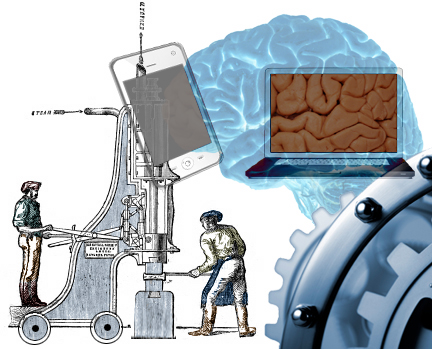
We are living in an age where we have come to expect that
computer software can be written to do the impossible. What we failed to do with
our minds, we have been able to do with the code we put into the memory chip of
a computer, correct? It is the brain
that can do all things, like bend steel with a simple code. For all of you who
are old enough to remember, there is an old American folk tale about big John
Henry, the railroad worker who was born with a hammer in his hand. The tale
goes that the railroad was planning to cut through a stone mountain and had
purchased a steam-powered hammer to do the work of ten men. John Henry
challenged the owners of the railroad to a contest. He would work his hammer,
cutting drill holes to blast a tunnel into the mountain, and they would do the
same with their steam machine. Could the brawn of one man with a hammer
overcome the mechanization of his job? At the end of the story, you might
remember, John Henry wins the contest by his sheer will and determination, but
dies from exhaustion. And the next day, the steam hammer takes his place.
When it comes to marketing your business, the steam hammer
machine tends to be your web site and its close companions (social networking
sites, blogs, search engines, etc.) Are there limitations to these tools that
cannot be programmed to surpass a human touch? Here are a few marketing
essentials that cannot be replaced by your web site.
1. Making
a personal connection with another human being. We are social creatures.
Even if you have photos of nice-looking customer service reps waiting to
talk to your customers, more than likely the photos are not really the
people who work for you. They are stock art models – they are make
believe. Some marketing bloggers are suggesting that a personal connection
with another person is as important today than it ever has been*. The
mechanization of this (social networking, Twitter, continuous texting) can
only go so far. In our own surveys with our clients’ customers, the
leading reason why they retain those customers is a relationship with a
sales rep, not an informative web site. People are wired to connect with
people relationally.
2. Reading
emotions and reacting to solve the issue. Emotions are subtle, too subtle
for a computer program to figure out. In marketing, we go to great lengths
to make sure the customer is happy with the work we have done for them. We
conduct web-based customer satisfaction surveys to make sure we are not
making the same mistakes time and again and to correct actions that have
fallen short in the eyes of our customers. However, if you are paying
attention, you know when something is wrong with a client relationship
before the survey is ever filled out.
3. Waking
up in the middle of the night with the solution. How many times have you
faced this marketing dilemma? Your labors have not gotten any traction in
the form of sales. There is some roadblock between your marketing efforts
and your customers’ decisions to purchase from you. You put a lot of time
and thought into a new solution. In the middle of the night a
serendipitous idea comes to you that removes the roadblock. Your computer
can’t do that.
4. Raising
suspicions. Every now and then I encounter a situation that is not quite
right. It is a gut reaction. It may be a mistake has been made, we are
dealing with a shady business character, or just a bad deal. In marketing,
there are hunches that things are not going right that cause me to put on
the brakes and re-examine what it going on around me. This feeling of
uncertainty is key to making marketing work and it cannot be replicated on
your computerized marketing devices.
5. Creativity.
There is something creative about the human experience that comes out in
marketing. But hold on there, you may be thinking. What is more creative than
a good web site, great internet video, or a great tweet that drives people
to purchase a product? I am not talking about the creative execution of an
online medium. I am talking about the wellspring of methods to capture the
attention of a target audience. One of those methods is the internet
itself, from which grew the new media. But it involves much more and
marketers are always looking for that new angle. It has been going on
since before someone put up a step-by-step Burma Shave outdoor sign
campaign.
Keep in mind that in the story of John Henry, what they
didn’t tell you is that diesel engines eventually replaced steam-powered
devices. There will always be a new device, but you cannot replace the human
factor.
_________________________
American Folklore.net http://americanfolklore.net/folklore/2010/07/john_henry.html
*Has
Facebook Lost The Personal Touch? www.ScottGradneronline.com